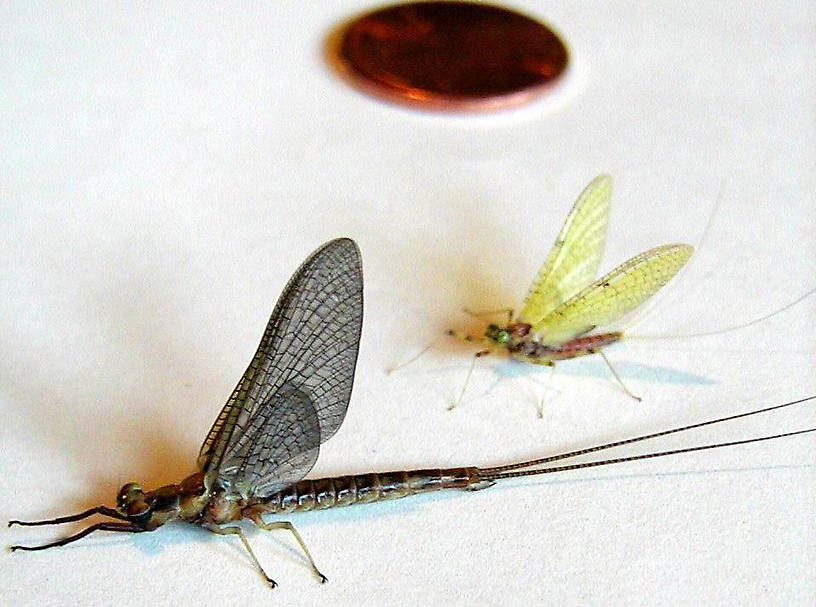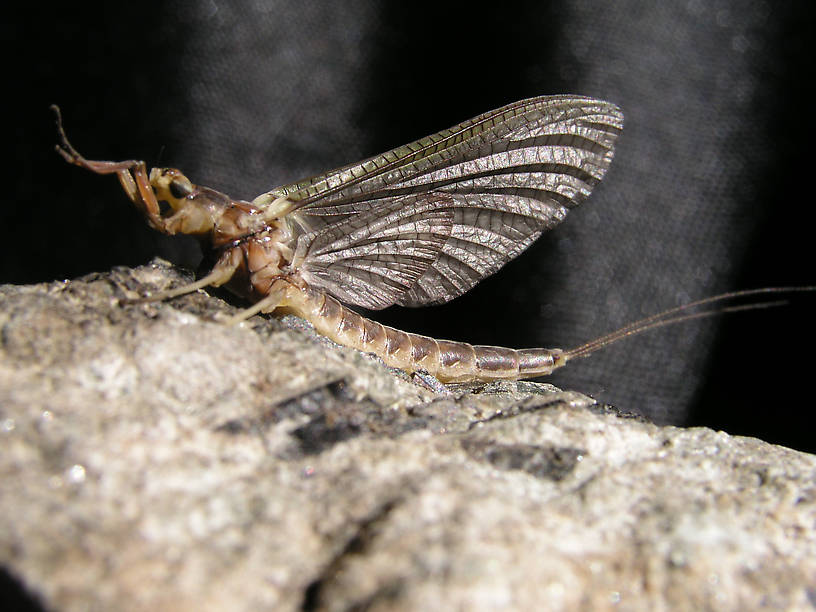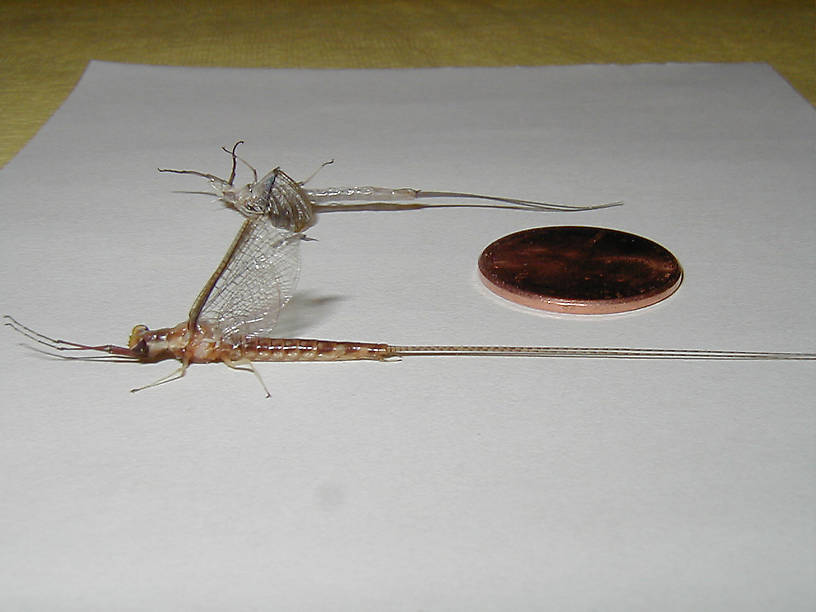Blog & Latest Updates
Fly Fishing Articles
Insects by Common Name


> > Mahogany Dun?



| TroutNut2 | June 13th, 2007, 1:00 pm | |
| Maine Posts: 2 | Here is a few pictures of a mayfly that I collected and we just had another "hatch" this weekend. I will try to get some better pictures this weekend if we have another hatch. | |
| Troutnut | June 13th, 2007, 2:12 pm | |
Administrator Bellevue, WAPosts: 2737 | The big one in front is probably Hexagenia limbata (or just "Hex") and the yellow one in back is some kind of Stenacron (light cahill). | |
| Jason Neuswanger, Ph.D. Troutnut and salmonid ecologist | ||
| Taxon | June 13th, 2007, 3:24 pm | |
Site Editor Royse City, TXPosts: 1350 | How about Isonychia bicolor and Stenacron? | |
| Best regards, Roger Rohrbeck www.FlyfishingEntomology.com | ||
| Troutnut | June 13th, 2007, 4:30 pm | |
Administrator Bellevue, WAPosts: 2737 | It's definitely Hexagenia. The markings look pretty much like limbata but I wouldn't conclusively rule out other species... that's just by far the most likely one. | |
| Jason Neuswanger, Ph.D. Troutnut and salmonid ecologist | ||
| GONZO | June 13th, 2007, 7:26 pm | |
Site Editor "Bear Swamp," PAPosts: 1681 | The various guises of limbata are amazing. At first glance, I would have guessed atrocaudata simply because it is so dark, but I only see limbata and rigida listed for ME. And this definitely doesn't look like rigida. From the body color of the Stenacron dun, it appears to be a female. | |
| Wiflyfisher | June 14th, 2007, 7:34 am | |
| Wisconsin Posts: 663 | Actually, isn't the male Hex limbata smaller and dark reddish brown, like the photo? When I see the darker flies they do remind of atrocaudata. I don't see atrocaudata hatching until mid to end of July and the hatch is very sparse. | |
| John S. https://WiFlyFisher.com | ||
| TroutNut2 | June 14th, 2007, 8:44 am | |
| Maine Posts: 2 | I will try to send more pictures. | |
| Troutnut | June 14th, 2007, 10:08 am | |
Administrator Bellevue, WAPosts: 2737 | Yeah, the males are smaller and come in various darker shades. The wings are usually gray like this one. Here's one of mine which looks very similar to the one posted here: http://www.troutnut.com/specimen/603 | |
| Jason Neuswanger, Ph.D. Troutnut and salmonid ecologist | ||
| Nightfisher | June 14th, 2007, 11:29 am | |
| Posts: 7 | Too small for hex if that is a penny next to it. They are bigger than a silver dollar out by me. | |
| Nightfisher | June 14th, 2007, 11:31 am | |
| Posts: 7 | Im guessing the big one is an iso. | |
| Troutnut | June 14th, 2007, 12:11 pm | |
Administrator Bellevue, WAPosts: 2737 | It's a Hex. The males are usually quite a bit smaller than the females, and there's quite a bit of individual variation within populations. Also, depending on the water, they might just not grow quite as large. | |
| Jason Neuswanger, Ph.D. Troutnut and salmonid ecologist | ||
| Nightfisher | June 14th, 2007, 1:38 pm | |
| Posts: 7 | i dont know about that. Still say its a slate wing. I guess the big question is was it taken from hex water. Do I read things correctly that it was taken from a river in Maine? Do you guys get hex up there? We sure get them here in Michigan. Out here it is Hex central right about now. | |
| Troutnut | June 14th, 2007, 5:29 pm | |
Administrator Bellevue, WAPosts: 2737 | Compare my pictures of Hexes to my pictures of Isonychias. The overall shape and proportions (the "look") of the two is very different. This is especially clear in the head, the prothorax (section to which the front legs are attached) and in the length and taper of the body. Isonychia also doesn't come in the color, or with the markings, of this mayfly. | |
| Jason Neuswanger, Ph.D. Troutnut and salmonid ecologist | ||
| Wiflyfisher | June 15th, 2007, 6:16 am | |
| Wisconsin Posts: 663 | I agree with Jason, it's defintely a Hex. specie of some sort. Iso's have an entirely different shape and a more solid coloration. Digital photos can be deceiving especially when displayed on different monitors as a jpg. I just grabbed a Wisconsin Hex. male off of our porch screen and set him on a penny. The photo is sort of crappy but you will see he is not that much longer than a penny. http://www.wiflyfisher.com/namie/male-hex.jpg | |
| John S. https://WiFlyFisher.com | ||
| GONZO | June 17th, 2007, 10:18 am | |
Site Editor "Bear Swamp," PAPosts: 1681 | Actually, isn't the male Hex limbata smaller and dark reddish brown, like the photo? Right, John, though the males do vary quite a bit as well. And the atrocaudata hatch timing is usually later than limbata, with some overlap in many places. The atrocaudata often have dark staining around the rear margin of the hind wings, but this seems variable and is absent in some males I've observed. (And I often see photos identified as limbata that also have this staining.) My most useful field ID trait for atrocaudata is to look for the dark, paired longitudinal dashes on the dorsal surface at the rear of the abdomen (between the angled hashmarks that meet the lateral midline). These paired dorsal dashes continue only faintly over the rest of the abdomen in some specimens, but they are usually very distinct on segments (7), 8, and 9. On rigida and many limbata, these marks are replaced by single, thicker dashes that form a "trident" shape in conjunction with the angled hashmarks, and can also be most prominent at the rear of the abdomen. Rigida is the palest of the three, but this alone is not a reliable distinction because limbata females can also be very pale in some locations. The shape of the "nose" in the nymphs and the distinctive shape of the male "organ" are about the only ways I know to confidently distinguish beween rigida and limbata. Do I read things correctly that it was taken in a river in Maine? Do you guys get hex up there? Nightfisher, although not as famous as the Midwestern activity, Maine does have good Hex hatches, as do NY, PA, and many other Eastern states. Eastern Canada also has good hatches. Limbata is a transcontinental species, contributing good Hex activity to the West and most other parts of the country. Perhaps the greatest variety of Ephemeridae species is found in the upper Southeast and Mid-Atlantic States, with four Hex species and relatives like Litobrancha, Pentagenia, and several Ephemera species contributing to a great wealth of big Ephemeridae drakes there. | |
Quick Reply
You have to be logged in to post on the forum. It's this easy:
Related Discussions
| Title | Replies | Last Reply |
| Re: Stenocron / Maccaffertium(Light Cahill) ... ? In the Identify This! Board by Wiflyfisher | 13 | Sep 14, 2011 by Jmd123 |
| Probably another E. vitreus In Male Epeorus vitreus Mayfly Spinner by GONZO | 0 | |
| Re: Agnetina capitata In Agnetina capitata Stonefly Adult by DOS | 6 | Mar 29, 2009 by GONZO |
| Re: Litobrancha in Minnesota In the Mayfly Genus Litobrancha by Dryfly | 5 | Aug 30, 2009 by GONZO |
| Re: Thoughts In Male Eurylophella Mayfly Spinner by Taxon | 5 | Mar 7, 2013 by Entoman |
| Re: Fallceon species mating In General Discussion by Millcreek | 7 | Dec 1, 2015 by Millcreek |
| Re: Northern Minnesota Hex. In the Identify This! Board by Gutcutter | 23 | Jul 30, 2013 by Crepuscular |
| Re: Hexagenia limbata vs rigida In the Identify This! Board by Aafloyd | 4 | Nov 2, 2011 by Jmd123 |
| Re: Unidentified Mayfly Kansas City, MO In the Identify This! Board by Pdcox | 4 | Apr 16, 2020 by Taxon |
| Re: April Fool's In General Discussion by Troutnut | 25 | Apr 6, 2009 by Martinlf |
Troutnut.com is copyright © 2004-2024 Jason
Neuswanger (email Jason). See my FAQ for information about use of my images.
 privacy policy
privacy policy


